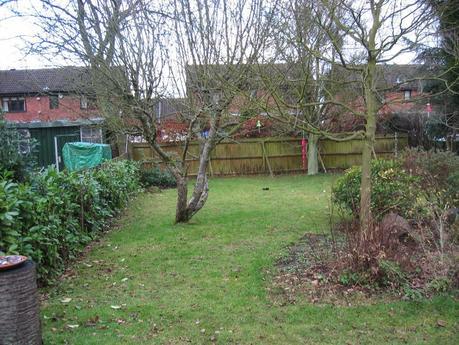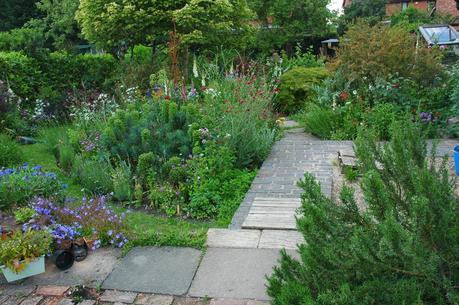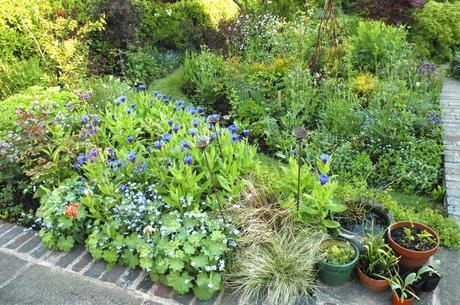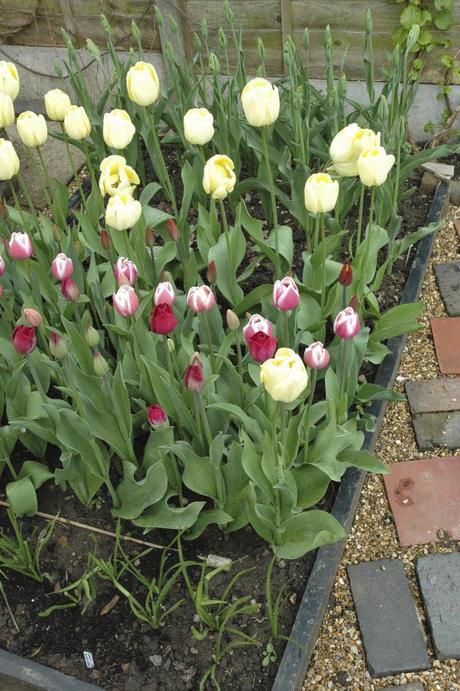
The most common comment I get on my market stall is: "Marmite jars! What a good idea!"
The second most common is:"Your garden must be lovely."
I think seeing a stall full of cottage garden flowers, people are intrigued as to where they have come from. So for those of you who want a sneaky peek into the Tuckshop Garden, walk this way.

Before….
When we moved into this house, the garden was wall-to-wall lawn, with a few trees, tired shrubs and lots of ground elder and conifers. First stop, tree surgeons. In with the chainsaws and down with the conifers. Light reached the soil and things started to grow - as did the ground elder (and still does - grrrr). With every passing year, the amount of lawn is reduced and planting areas extended - much to the disgust of my eldest son who has a passion for petrol-powered lawn mowers.
Some time after….
Even since this photo was taken, the planting areas have extended: the expansive patio has now been reduced - a significant number of slabs have come out, and a largish border created in their place, further bringing the garden right up to the house.
It is a place of constant change - every season brings different flowers, and every year brings new areas coming under development, or old areas which had been left to their own devices getting a significant overhaul. The one thing I've learned in my gardening life is that plants don't last forever. And when they start to run out of steam, I'm afraid I'm quite ruthless. Get them out, take cuttings or divide them where possible, and put something else in to fill the gaps.
Last week was spent culling all the aquilegia which put on such a lovely spring display. But I know if I leave them in with their shapely seed heads rattling in the breeze, next year I'll have an forest of Granny's Bonnets nodding at me. Pretty though that may be, I don't want the garden to be a mono-culture, so out with the secateurs and off with their heads. And more often than not, out with their roots too to make way for some of my current crop of maturing seedlings which are begging to be planted out. It's the only way to keep things productive and to keep colour coming later in the season.
The tulips in my raised bed on the patio have been over planted with dahlias and sweet peas and these are now just starting to flower. I'm so pleased I took the sledgehammer to this particular area of concrete as I now have something much nicer to look at out of my kitchen window.

I've got a tulip catalogue on my desk and a wish list in my head - so am already plotting and scheming about where I can make my tulip bed next spring, and what to use the raised bed for instead. Tulips don't really flower brilliantly after they've been in for a couple of years, so the ones above are due for replenishment. I always feel a bit guilty for abandoning flower stocks that have served me well, but getting them out gives me chance to put some goodness back into the soil with compost, leaf mould, manure and other such additions. And as soon as the replacement plants start to flourish, I'm afraid I never look back!
So don't be afraid to overhaul scruffy patches, or be lenient with tired plants. Prune them, split them or chuck them - but do these jobs in spring or autumn if you want them to regenerate elsewhere in the garden.
If you want to see more pictures of the garden, visit my Pinterest board.
This post has reminded me that I need to take some more photos of the garden as it is now - I've got lots of flower photos, but not so many of the garden as a whole. Next project….

